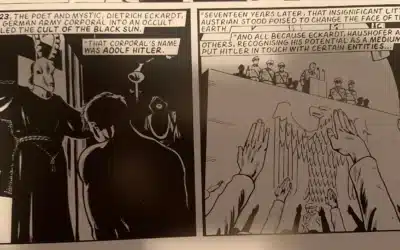The Federal Bureau of Investigation (FBI), as a federal agency, is subject to the provisions of the Freedom of Information Act (FOIA), which requires the release of certain records upon request from the public. FOIA compels the release of these records unless the information falls under one of nine exemptions, including national security, personal privacy, and law enforcement investigations.
The FBI has been widely criticized for its frequent invocation of the national security exemption to withhold information from the public. In some cases, the FBI has withheld documents from release without providing any reason, but instead by simply excluding relevant records when responding to a FOIA request.
“National Security” — Deceiving the Public, Courts, and Judges
A good example of the FBI misusing the national security exemption can be found in its responses to FOIA requests concerning federal law enforcement’s use of cell-site simulators, also known as “Stingrays,” which are used to track the location of cell phones. In almost all requests—some leading to lawsuits—the DOJ has hidden behind the national security exemption, almost always refusing to release any information about the Stingray device. In a rare exception, in response to one lawsuit the FBI would hand over just two documents (out of an estimated 25,000) on the device. [1]
The agency’s evasive response to Stingray FOIA requests is mirrored in the lawsuits relating to the use of the Stingray device, through which it has been revealed that the FBI has engaged in practices designed to conceal from the public, courts, and even federal judges information about the device. For example, the FBI requires state and local law enforcement agencies to sign strict nondisclosure agreements (NDAs) before purchasing the device. According to the ACLU, “these agreements not only prevented cops from revealing their purchase or use of the technology to the public, but it even forced them hide it from judges and defense attorneys in court proceedings.”[2] The FBI’s response to Stingray FOIAs and their actions in criminal court cases highlight their tendency to use the national security exemption as an excuse to withhold information, while also demonstrating their unwillingness to fully cooperate with authorities even when doing so would be in their interest. For example, this approach has led to prosecutors actually dropping charges against suspects rather than forcing the FBI to have to answer a judge’s questions about the use of Stingrays. This covertness further illustrated by the fact that the FBI instructs local police departments on how to use Stingrays, and in doing so trains them to conceal from the public, the courts, and anyone else all information concerning the devices.
When the ACLU filed a FOIA request with the FBI for “any nondisclosure agreements entered into since 2018 to keep state and local law enforcement’s purchase and use of cell site simulators secret” as well as “information about other conditions imposed on local police when they purchase and use the technology,” the FBI opted for a “Glomar response,” meaning they refused to confirm or deny the existence of any relevant records.[3] To justify the “Glomar response,” the FBI claimed, without explanation, that acknowledging whether it has any NDAs about cell site simulators “would disclose the existence or non-existence of non-public law enforcement techniques, procedures, and/or guidelines.”[4] However, whether or not the FBI has continued to impose NDAs and other conditions on local and state police isn’t a secret law enforcement technique or procedure—its basic information about whether the FBI is continuing to hide things behind an unwarranted veil of secrecy.
These actions raise serious questions about the FBI’s commitment to transparency and accountability. Meanwhile, there are other factors relating to the Stingray cases that raise similar concerns about integrity. For example, federal law enforcement agencies have been documented instructing police departments and other law enforcement agencies to lie about the use of a Stingray device on applications for warrants. Specifically, law enforcement is told to falsely attribute Stingray-obtained information to a nonexistent “confidential informant” in the warrant.[5] In this particular instance, federal authorities cross the line beyond merely hiding information to actively suggesting agencies commit what is probably a felony (lying to a judge on a warrant application).
The FBI’s approach to criminal cases relating to Stingray devices and its response to FOIA lawsuits concerning them paint a picture of deception that is difficult to imagine if it weren’t so well documented. Addressing this behavior, one court ruled that “such an extensive prohibition on disclosure of information to the court…prevents the court from exercising its fundamental duties under the Constitution.”[6]
One can only wonder if this inarguably corrupt and unconstitutional posture extends beyond FOIA and the judicial branch and towards the very legislators responsible for funding the agency. If the extensive history of the FBI’s disrespect for the rule of law is any indicator, such a question probably requires no answer. It will eventually be up to the legislators responsible for federal funding and oversight to consider these important questions when examining the FBI’s track record of abuse.
A History of Excluding Relevant Documents in FOIA Requests
The FBI has a long history of failing to comply with FOIA requests, which in many cases has resulted in lawsuits from large organizations. It is important to consider that most FOIA requestors are individuals—not large organizations—and thus do not have the legal or financial means to undertake a lawsuit to force the Bureau to comply. Even then, a successful legal challenge and subsequent ruling from a federal judge still may not lead to the FBI complying with the request.
Compounding matters, the FBI has a history of excluding relevant records when producing FOIA releases. One example is the TWA-800 investigation. The FBI has on their website a large cache of standardized FOIA document releases, including a batch of FOIA documents from their TWA-800 investigation totaling about 700 pages. However, noticeably absent from those 700 pages are any FBI 302 reports from the plethora of witnesses who observed the TWA-800 accident.
They were known to exist based on the numerous newspaper articles citing witnesses who observed the accident firsthand and were subsequently interviewed. Independent researcher and veteran pilot Ray Lahr had to file an additional FOIA request to obtain the relevant TWA-800 witness accounts, and as a result, in 2005 the FBI turned over more than 500 pages of documents. Many more additional files not included in the official TWA-800 release were obtained by Lahr through his FOIA lawsuit against the National Transportation Safety Board and the Central Intelligence Agency (CIA), whose own records contained the very same FBI documents that had been inexplicably excluded from the official release on their website.
One can discern from Lahr’s extended legal battle that documents clearly relevant to a general FOIA request regarding TWA-800 were withheld from release by the FBI, and it was only after the additional FOIA request and subsequent lawsuit that relevant documents got produced. Consider: how many of the FBI’s other official FOIA releases, hosted on their website and reproduced to individual FOIA requestors, are missing hundreds of pages of clearly-relevant documents that might only be obtained through a lawsuit?
How many such cases exist where a potential lawsuit is not undertaken due to lack of financial or legal resources to fight that battle? In most cases, such an endeavor would be akin to a David versus Goliath, with the federal agency having incalculable financial and legal resources at their disposal and an intrepid journalist possessing comparatively meager resources to challenge them.
Enter Salt Lake City attorney Jesse Trentadue, who does possess the means, the legal skill, and the wherewithal to wage such a battle and has done so for over a decade concerning his own FOIA requests to the FBI which predictably produced, like so many before him, an FBI response leaving much to be desired. It is through examining Trentadue’s lawsuit that the FBI’s record of withholding and excluding relevant materials is laid bare, and the facts are damning.
Trentadue’s FOIA Request
Trentadue’s FOIA request was a straightforward one: on October 12, 2008, Trentadue submitted a FOIA requesting that the FBI produce all of the surveillance tapes acquired during their Oklahoma City Bombing investigation. Numerous newspaper accounts, television news broadcasts, FBI, and Secret Service documents confirm the existence of the surveillance tapes. A 1999 FOIA lawsuit by journalist David Hoffman revealed that the FBI at one time possessed 23 surveillance tapes, one stored under lock and key at FBI headquarters.
Predictably, the FBI produced for Trentadue an inadequate and incomplete collection of surveillance video that did not match the records in the FBI’s own archives of what videotape they had obtained during their investigation. As a result, Trentadue was forced to file a lawsuit to obtain the rest of the material.
Examining Trentadue’s case, we can learn a great deal about the FBI’s filing system and the fulfillment process the agency is supposed to follow. The specifics concerning these filing systems and the actions taken by the FBI are documented in detail in a “Proposed Findings of Fact and Conclusions of Law” that Trentadue filed with the court in his lawsuit, and upon which this article is largely sourced. Details from that document show that the FBI acted in bad faith to what should have been a simple request.
FOIA Request, to Lawsuit, to Trial
On May 5, 2011, Judge Clark Waddoups of the United States District Court for the District of Utah, Central Division issued an order to the FBI to conduct additional searches for videotapes and related records, based on information Trentadue provided to the court which demonstrated inadequacy in the FBI’s initial search.[7] Per the court order, if the FBI did not conduct those searches, the Bureau was to explain why such searches would not be reasonably calculated to locate the videotapes and documents requested. The FBI did not conduct the additional searches as directed[8], and neither did the FBI submit a credible explanation as to why. As a result, the court ordered that the case should proceed to trial.[9]
At trial, the FBI would have to show that it performed a search that was “reasonably calculated to uncover all relevant documents” and essentially prove that it made a good faith effort in its conduct, including not limiting its search to only one record system if others exist that are likely to turn up the requested information. Subsequently, the FBI would then be required by law to release to Trentadue all records that fell within the scope of his request. Given the policy of openness embodied in FOIA, the FBI was required to liberally construe what materials fell within the scope of Trentadue’s request, and to err on the side of inclusion and disclosure rather than exclusion and non-disclosure.[10]
Records from the trial show that the FBI failed to fulfill the court’s request, only searching a limited number of databases while narrowly interpreting Trentadue’s FOIA to improperly exclude relevant documents. This limited interpretation caused numerous responsive documents and/or videotapes to be excluded from turned over material. Trentadue was able to independently obtain, from journalist and former McVeigh defense team investigator Roger Charles, a large cache of documents that he later introduced as exhibits at trial. These exhibits constituted damning evidence in the form of multiple, highly relevant documents pertaining to surveillance tapes that should have been turned over to Trentadue, but were not.
Additionally, through testimony elicited from the FBI’s employees at trial, Trentadue was able to show that the Bureau did not search databases and/or sources that were reasonably likely to contain responsive records. In fact, the FBI confined its search to very limited sources, with testimony further revealing that they deliberately chose not to search several official record keeping systems likely to contain relevant materials. This happened primarily because the FBI chose an unqualified and untrained person to perform the FOIA search.
The FBI’s Strategy: Tactical Ignorance
The FBI’s Records Information Dissemination Section (RIDS) staff are responsible for responding to the agency’s FOIA requests.[11] They are prepared and personally supervised until they are specially certified to respond to FOIA requests, which requires between three and a half to four years of training.[12] As part of the certification process, RIDS personnel must pass several examinations demonstrating their proficiency. FBI Chief of RIDS, David Hardy, testified that such training is required to ensure that the FBI fulfills its “FOIA obligations to citizens.”[13]
However, uniquely in this case RIDS staff did not conduct the search for records responsive to Trentadue’s request. Instead, the search was assigned to one person, Linda Vernon, who works out of the FBI’s Oklahoma City Field Office. Vernon’s job title is “Forensic Accountant” and she testified under oath that searches of records for FOIA was not a regular part of her job responsibilities.[14] Likewise, Vernon also has no FOIA training or certification.[15] It is noteworthy that Vernon is untrained and unqualified to conduct such a search, and was provided with no guidance about how to interpret the scope of Trentadue’s request or whether materials located by her search fell within the scope of the request. As a result, Ms. Vernon located at least one videotape and numerous documents that were clearly within the scope of the FOIA request, but these were deliberately withheld because Ms. Vernon did not understand her duties under FOIA. This should raise serious questions about why the Bureau chose to have an untrained and unqualified person be the arbiter who decides which records were to be produced, and should cause serious skepticism concerning the FBI’s dedication to fulfilling its obligations under FOIA.
RIDS’ selection of Ms. Vernon to conduct the FOIA search is significant because when RIDS receives a FOIA request it is triaged for sensitive or potentially problematic cases, cases that “have a high likelihood of going to litigation.”[16] “These kinds of requests are “flag[ged],”[17] and brought to Hardy’s attention.[18] As a result of this triage process, Trentadue’s FOIA request was flagged as a potential problem and immediately brought before Hardy.[19] Consequently, tasking the untrained and unqualified Ms. Vernon to respond to Trentadue’s FOIA request does not appear to have been a coincidence.
In court filings, Trentadue characterized the FBI’s use of Linda Vernon as being part of a strategy by the “FBI to create a situation of ‘willful ignorance’ with respect to the foreseeable results of Ms. Vernon’s search for the videotapes and records.”[20] Trentadue suggested that “the FBI had, in other words, created a situation of tactical ignorance whereby Ms. Vernon could reasonably be expected to fail in terms of locating and/or producing videotapes and documents responsive to Plaintiff’s FOIA request. On the other hand, under this manufactured cloud of ignorance, the FBI could represent to the court that a proper search had been conducted.”[21]
Prior to Trentadue’s FOIA request, Ms. Vernon had served as the FBI’s “Discovery Coordinator” at the McVeigh and Nichols trials.[22] Her job responsibilities included assembling the prosecution’s evidence and providing it to defense counsel.[23] It was reasonable to expect, therefore, that in conducting a search for records responsive to Trentadue’s FOIA request Ms. Vernon would confine her search to the material that had been provided to the McVeigh and Nichols defense counsel, and not look beyond that very narrow set of FBI records, which is exactly how Vernon conducted her search. When asked why she did not search the FBI’s official filing systems and instead relied on an unofficial personal database, Ms. Vernon testified that “I’m lazy and it was the easier one for me to use.”[24] This response speaks to the FBI’s lack of commitment to fulfilling its requirements under FOIA.
Inside the FBI’s Filing System
To understand how the FBI failed to perform even the most basic types of searches to fulfill Trentadue’s FOIA request, it is necessary to describe the FBI’s filing system. The FBI’s Central Records System (CRS) contains the universe of records that the Bureau has acquired over the course of its day-to-day law enforcement responsibilities.[25] It is the FBI’s “primary records” system.[26]
The FBI’s Automated Case Support (ACS) system contains various tools for conducting electronic searches for records contained in the CRS.[27] ACS is specifically designed and maintained to identify and locate FBI records.[28] ACS consists of three components: the Investigative Case Management system (ICM), the Electronic Case File (ECF), and the Universal Index (UNI).[29]
ICM is used to open and close cases. It is a case management tool for the agents and personnel working on an investigation[30], and contains information on the items logged in as evidence. Meanwhile, ECF contains uploaded versions of the documents contained in the Central Record System.[31] The ECF contains all FBI generated documents except for “restricted documents” which, for various but unknown reasons, are not uploaded.[32] The ECF is not limited or otherwise confined to one case, such as OKBOMB, but contains all of the FBI’s non-restricted investigative records.[33] The documents or records that have been uploaded to ECF are text searchable.[34] Meanwhile, restricted documents or records not uploaded into the ECF database are identified on an index and are located and retrieved by a manual search.[35]
Because the FBI documents and records contained in ECF are text searchable, it is possible to search for and locate misplaced or misfiled records.[36] In the case of Trentadue’s request, RIDS Chief David Hardy falsely testified that misfiled or misplaced records could not be located. He testified that “it is always a possibility that responsive documents might have been misfiled and thus could be located somewhere other than in the OKBOMB file, though it would be impossible to know where.”[37] Meanwhile, a basic text search of ECF could and would identify potentially responsive records if they had been misfiled. It is noteworthy that RIDS staff and/or Ms. Vernon did no text-based search of the ECF database for documents responsive to Trentadue’s FOIA request.[38] The failure to search ECF, and Hardy’s testimony concerning the Bureau’s inability to locate a misfiled record, are just one example of the FBI’s efforts to mislead the court, and a specific example of RIDS Chief Hardy lying under oath.
Regarding restricted records not uploaded into the ECF, they can be retrieved by a manual search of the ECF indices. It is notable that RIDS and/or Ms. Vernon did no manual search of the ECF indices for records responsive to Trentadue’s FOIA request.[39] This is another specific example of the FBI failing to perform an adequate search for responsive records. It is perhaps not surprising, however, given that the FBI first failed to perform a search of the standard ECF, UNI, and ICM systems.
The FBI told the court that RIDS did no search of the ECF database via ACS because the Oklahoma City Bombing occurred in April of 1995, whereas the ACS system did not come online until October of 1995.[40] In stating this, the FBI was suggesting that the ECF would therefore contain no records related to OKBOMB. However, Ms. Monica Mitchell, who was Linda Vernon’s contact person within RIDS, testified that FBI records after 1978 are currently in the ACS system.[41] In addition, RIDs Chief Hardy testified that all of the OKBOMB records had been “uploaded into ACS.”[42]
Therefore, the FBI’s excuse for not searching ECF using ACS is not a credible one. Indeed, this records system should have been one of the first databases searched by the FBI to fulfill Trentadue’s FOIA request, and it should also have been searched when the court directed the Bureau to go back and examine all databases where it would be reasonable to conclude there would be responsive records.
RIDs did perform a search of one of the other databases that is part of ACS, the Universal Index or UNI.[43] Like the ECF database, UNI came online in October 1995; one of the records found in UNI (but not turned over to Trentadue) related to the FBI having taken possession of a videotape from a surveillance camera at the Regency Tower Apartments on October 26, 1995 which would have been after the ECF came online.[44]
This search shows that the FBI was fully aware that the ACS system would likely have responsive records in ECF, but they failed to search it. Meanwhile, it also shows that the FBI narrowly interpreted Trentadue’s FOIA request and thereby improperly excluded the October 26, 1995 302 report found by Vernon and not turned over.
It’s noteworthy that RIDS’ policy is to use the Universal Index or UNI for all of its FOIA searches, rather than the ECF.[45] The UNI, however, is obviously a less accurate search tool than the ECF for locating and retrieving records. Unlike the ECF database, records or documents are not uploaded into the UNI, and so text-based searches cannot be conducted. Instead, the UNI is searched by entering key terms such as a subject’s name, event, or organization, etc.[46] However, the FBI agent who prepares a report or investigative document is the one who enters this information, and he or she has the discretionary authority of how that document is described in the UNI for future search and retrieval.[47] If the appropriate terms are not entered by the agent, such as “Murrah Federal Building,” “Regency Tower Apartment Building,” “Southwest Bell Building,” “YMCA Building,” or “video” or “camera,” then the document or record cannot be retrieved using the UNI.
It is impossible to know how effective a search of the UNI would have been using the aforementioned terms, because the one search conducted by RIDS personnel of the UNI was done using the generic term “OKBOMB.”[48] Following this, records were examined by Linda Vernon from the OKC Field Office, who as previously mentioned acted as an arbiter to determine which records to turn over to RIDS for processing before being sent to Trentadue. Unsurprisingly, Vernon withheld a number of responsive records due to inadequate training and improperly interpreting Trentadue’s FOIA request. These withheld responsive records, to follow, were introduced as exhibits at trial and are provided for the reader to examine to see just how egregious the FBI’s exclusion of records was in this case.
Key Responsive Records Culled and Improperly Excluded
Two excellent examples of Vernon (and by extension, RIDS, RIDS Chief Hardy, and the FBI) excluding relevant records from Trentadue’s FOIA request were introduced as exhibits at the trial, Exhibit 35 and Exhibit 37.[49] These exhibits were both FBI 302 reports concerning the FBI’s acquisition of videotapes of the bombing.
Exhibit 35 is an FBI 302 reporting that the FBI took possession of a videotape from one of the Regency Tower Apartment Building’s surveillance cameras that had been “blown off the wall” by the explosion and that this tape might contain a “photograph of the persons responsible for the bombing of the Alfred P. Murrah Building.” Exhibit 37 is an October 26, 1995 302 reporting that a surveillance tape had been recovered from a security camera on the Regency Tower Apartment Building. Both of these records fell squarely within Trentadue’s FOIA request letter but were withheld by Ms. Vernon and not sent to RIDs for processing and release.[50] Ms. Vernon freely admitted in court that she found and withheld this highly-relevent document, excerpt from testimony follows:
THE COURT: Let me make sure I’m clear on this. Is this a document that you found during your search or not? That is Exhibit, Plaintiff’s Exhibit 35?
THE WITNESS: One second, your Honor. When I did my searches, yes, I found it. I did not include it.
THE COURT: Did you – and you didn’t send it to the– Ms.Mitchell?
THE WITNESS: No, sir, I did not.
THE COURT: You made a decision yourself not to forward this document?
THE WITNESS: Because I read his description and he asked for when it was provided to evidence.
THE COURT: A little while ago, you testified that you always erred in the side of including documents if there was any doubt. What was it that led you to believe that this document should not be sent and let someone who understood the Freedom of Information Act make the decision?
THE WITNESS: Just the way it was worded, sir. It showed that it was just mainly Mr. Payne gave it [the videotape] to Mr. Hippard. It doesn’t really say that it— I mean in Mr. Legleiter’s 302, I’m assuming it had more information that is why I picked it at that point.
THE COURT: But this document seems very much on point as to the request that was made, does it not?
THE WITNESS: And he got the videos for this document, yes, sir.
THE COURT: But you made the decision, on your own, without consulting with anyone else, to exclude this document, is that correct?
THE WITNESS: Yes, sir, the way I read it in 2008.
This testimony is highly notable for several reasons. First, Vernon is mistaken here: Trentadue did not receive the Regency towers videotape referenced in the 302 report which was likewise withheld from him. Additionally, the other tapes that he did receive from the FBI appeared to be edited to remove footage of the truck bomb being delivered to the Murrah Building. Secondly, if the evidence in the case were limited to just this testimony by Ms. Vernon in response to Exhibit 35, Trentadue would prevail because it shows that 1) the FBI did not do a search reasonably calculated to locate all responsive records 2) because a responsive record was found but deliberately withheld from Trentadue and 3) because through a lack of training Ms. Vernon had unlawfully construed the scope of Plaintiff’s FOIA request to narrowly cover only those records showing videotapes being logged into evidence. However, the evidence of the FBI’s failure to fulfill its FOIA obligations is far greater than just Vernon’s response to Exhibit 35; the same can be said for Exhibit 37, withheld on the same grounds, in addition to many others. For example, Trentadue introduced Exhibit 62[51] at trial which reports that on the afternoon of April 19, 1995, an FBI agent acquired a surveillance tape from the “Security Officer of the Oklahoma City Public Library.” In his FOIA request, Trentadue asked specifically for any video recordings taken by cameras mounted on the Public Library, as well as documents proving the FBI had possession of these videotapes. However, Exhibit 62 was also withheld. Trentadue should have been given this document, but Ms. Vernon “culled” it from those documents that she forwarded to RIDS.
Ms. Vernon also found but kept from RIDS Exhibit 69, which reports that the FBI had examined video footage from an ATM machine at the Regency Apartments in which the Ryder truck driven by Timothy McVeigh could be seen. In addition to videotapes taken from surveillance cameras on specific buildings, Trentadue’s FOIA request asked for “tapes showing McVeigh and another person, delivering the bomb to the Murrah Building on April 19, 1995.” This ATM tape clearly came within the scope of Trentadue’s FOIA request since it captured the bomb being transported to the Murrah Building. The FBI is in possession of this videotape, but it was not among those turned over to Trentadue. It, too, was excluded.[53]
Ms. Vernon likewise found during her search Exhibit 36 and Exhibit 60[54], which describes tapes from the Journal Record Building and Southwest Bell Building “testing positive” for images or sounds of the explosion or “main subjects” in the bombing investigation. It is important to note that this document delineates at least two of the videos the FBI had in their possession as being of “evidentiary value” because it shows the bombing and/or the perpetrators. However, this document, like all the rest, was improperly excluded and not turned over to Trentadue.[55]
Trentadue also introduced as evidence Exhibits 55, 56, 57, 58, 65, and 66 which are Bureau records reporting an alleged attempt by a Los Angeles-based FBI agent in the fall of 1995 to sell to Dateline NBC video footage showing McVeigh and another suspect exiting the Ryder truck and the bomb exploding for “$880,000.00 [the equivalent of almost $2 million in 2023 dollars] to be paid in a manner so as not to create a paper trail.” This attempted sale resulted in an FBI Office of Professional Responsibility investigation, and can be read about here.[56] These exhibits, all FBI memos about the videotapes and their attempted sale, were likewise “culled” and excluded by Linda Vernon and not turned over to Trentadue despite clearly falling within the scope of his request.[57]
FBI Lies Concerning I-Drive/S-Drive Contents, Inability to Search
At one time, the OKBOMB file was a “restricted file.”[58] “Restricted” means that someone within the Bureau’s chain of command would have to review a report or other investigative document before it could be placed into the official case file.[59] Once a document is approved, it is uploaded into the official case file where it would be turned over to defense counsel in a criminal case or subject to production in response to a FOIA request.[60] Conversely, if a document is not approved for uploading into the official file, then it will not be produced in response to a FOIA request.[61]
While a document is under review for uploading into the official case file, it remains in the I-Drive, and during the OKBOMB investigation, there was an I-Drive in the Oklahoma City FBI Field Office.[62] The I-Drive was a “shared drive,” meaning that a supervisor could access and review an agent’s work, including making changes or modifications to a document before it was uploaded into the official file.[63] Documents not approved for uploading into the official case file remained in the I-Drive.[64]
The Oklahoma City Field Office’s I-Drive was eventually deprecated and replaced by the S-Drive[65], which is currently in use at that location.[66] The S-Drive serves the same purpose as the I-Drive[67] and functions exactly like the I-Drive.[68] More importantly, as part of the replacement process, documents not placed into the official case file and remaining on the I-Drive in the Oklahoma City Field Office were moved to the S-Drive.[69]
The FBI was ordered by the court to conduct a search of both the I-Drive and S-Drive located in its Oklahoma City Field Office. If no search was conducted, then the FBI had to explain to the court why such a search would not be reasonably calculated to locate the requested videotapes and other materials. The FBI conducted no search of the I-Drive or S-Drive in the Oklahoma City Field Office for documents or records responsive to Trentadue’s request.[70] In an attempt to explain why, RIDs Chief David Hardy said that RIDS had never done an I-Drive search.[71] Mr. Hardy also stated that to conduct such searches would be so burdensome that he could not even provide the court with a “reasonable estimate of the time necessary” to do such a search.[72] Both statements, however, are lies and it’s worth noting in conjunction with Hardy’s lying to the judge in the Trentadue case that this is a pattern. In another case, “the court found the Government, and Mr. Hardy specifically, to have provided false and misleading information to the court.”[73] Incredibly, when the deception was revealed, in that case, Mr. Hardy’s counsel argued that it “had the authority to mislead the court.”[74]
Regarding Hardy’s deceptions concerning the supposedly never before searched I-Drive and S-Drive, Trentadue elicited testimony that showed RIDS had in fact searched both the I-Drive and S-Drive in the FBI’s Oklahoma City Field Office for responsive records in other FOIA requests.[75] Such searches can and have been done. Furthermore, under cross examination, Mr. Hardy admitted that in another FOIA matter he had signed a sworn declaration stating that “[A] search of the I and S Drives at the Oklahoma City Field Office” had produced no responsive records.[76] Mr. Hardy also stated under oath that a search of the S-Drive at the Oklahoma City Field Office would be “fruitless” because the S-Drive did not exist at the time of the OKBOMB investigation. However, as with Hardy’s claim that RIDS had never searched the I-Drive or S-Drive before, that statement was also false: It is undisputed that when the I-Drive system at the Oklahoma City Field Office was replaced by the S-Drive system, all documents or records remaining on the I-Drive were moved to the S-Drive.[77]
RIDS Chief David Hardy misled the court in Trentadue’s FOIA case when he falsely asserted that the FBI could not search the I-Drive/S-Drive system, and likewise lied when he said such a search had never been conducted before even though his office had performed searches of this system to fulfill previous FOIA requests. Therefore, Hardy’s statements concerning the FBI’s inability to determine a “reasonable estimate of the time necessary” to perform a search should be viewed with considerable skepticism. The overall pattern of behavior displayed by the FBI and David Hardy regarding the I-Drive and S-Drive—much like the FBI’s posture throughout this entire lawsuit, and others before it—was one of deception, obfuscation, and lies.
To summarize, the FBI failed to search any of its official record keeping systems within ACS: not ECF, UNI, or ICM. The FBI failed to perform any search of the indices of the restricted files. Finally, the FBI also failed to perform a search of the I-Drive/S-Drive systems and then lied to the court about why this was not undertaken, even though it had been done in the past.
Ultimately, what the FBI did in response to Trentadue’s FOIA request was have an untrained and incompetent person perform a search of an unofficial database for records. That employee, Linda Vernon, then improperly excluded from the results of her search nearly a dozen documents that were plainly responsive to Trentadue’s FOIA request. Meanwhile, the FBI’s agents and employees lied to the courts when providing excuses as to why they failed to perform certain searches.
What becomes clear after analyzing this pattern of deception and lies is that the FBI cannot be trusted to fulfill their duties under FOIA and routinely refuses to comply with court-ordered searches, then lies when advising why they did not do so. Due to the severity of the situation, and a total lack of accountability, the only reasonable solution is comprehensive FOIA reform and increased oversight.
Reasonable Reform
Congress needs to undertake a major overhaul of FOIA. Under the FOIA law currently on the books, for example, the citizen or requestor may be given an award of attorneys’ fees if they win their FOIA case. However, it must once more be stressed that most people don’t have the financial resources to wage a FOIA lawsuit, much less await reimbursement for the costly fees involved. Meanwhile, few, if any, lawyers will take a FOIA case on contingency; whereas government agencies have unlimited legal resources to commit to any case. This leaves most requestors unable to pursue their case even if they know with certainty they have a legitimate FOIA complaint that could likely result in a legal victory.
In order to remedy the present situation with respect to the FBI’s resistance to the FOIA process (and presumably, other agencies, though the FBI is historically one of the worst offenders), the law should be changed to be more aligned with transparency and fairness, in the spirit with which the law was originally created. To that end, some changes that would constitute much-needed reform include:
- If the citizen or requestor has to bring a lawsuit against an agency in order to obtain their requested documents and prevails, FOIA law should provide that they shall be awarded their reasonable attorneys’ fees or the sum of $100,000.00 (whichever sum is greater). This provision would encourage attorneys to take FOIA cases on a contingency basis.
- It should be codified in law that there is a presumption in favor of disclosure, and that it is the FBI’s (or other agencies’) burden to overcome that presumption. There should also be a provision in the FOIA law whereby after the passage of so many years (i.e., 25-years) the disclosure presumption becomes irrebuttable in the absence of extraordinary circumstances justifying non-disclosure, with the agency having the burden to prove the existence of those extraordinary circumstances by clear and convincing evidence.
- Responses to FOIA requests should require that the FBI or other agencies respond within 30-days of a request advising the requestor of both the number of potentially responsive records located, and an assertion of the exemptions from disclosure that may apply to those documents. Penalty for a failure to comply would be that any future exemptions the agency may later claim will be waived. It’s notable that under current law, agencies are given 20 business days to respond to a request; a deadline they almost always, without consequence, fail to meet. This change would increase the amount of time to respond to a request by a reasonable amount while also establishing consequences for failure to abide by the law.
- For large requests, documents should be released in 500-page increments as they are processed, rather than having the requestor wait years and sometimes a decade or more to receive the resulting documents all at once. It is reasonable to allow for a request to be fulfilled in increments, as the pages are processed.
- FOIA should require an agency to perform a text search of all its databases for responsive documents rather than an agency ad-hoc, without consistency, choosing to narrow the scope of requests to a specific and sometimes limited set of databases. Allowance must be given to a FOIA requestor who is ignorant of particular databases and unable to tailor their request to include them explicitly. As it is now, a request submitted to the FBI might fail to cause a records search of one or more databases unless specifically requested, and even in that instance (as shown with the Trentadue lawsuit) the FBI has failed to perform the requested searches of the specified databases.
- Federal courts should be permitted to look behind an agency’s claim of a national security exemption, with an objective arbiter such as a specially appointed federal magistrate or judge serving as an impartial buffer between the federal agency and the requestor to determine if the national security exemption is legitimate.
- All agencies withholding documents from release under FOIA must always, in all cases, provide both the court and the requestor with a Vaughn index stating the basis for withholding each document, and the court must conduct an independent albeit ex parte review of the documents in order to confirm if the claimed exemptions are applicable. Review by the court is important because any “reasonably segregable portion of a record” shall be provided to any person requesting such record after deletion of the portions which are otherwise exempt. In other words, the agency must redact the exempt material from the document and disclose the remainder, which they rarely do, and mandatory review by the court should alleviate this problem. Under current law, a Vaughn index is only created when ordered by the court.
- In addition to an award of attorney’s fees, there should be a formal monetary sanction imposed upon an agency that wrongfully withholds documents that gets imposed upon the agency’s annual funding allocations. This would make compliance with FOIA by federal agencies a metric that will help determine funding levels.
- Agencies must be required to designate individual(s) in their organization whose job is to handle FOIA requests and provide those individuals with specialized training on how and where to search, and these individuals must be certified to understand and comply with the requirements of FOIA law.
- If a requestor has to sue to obtain records, he or she should be entitled to a jury trial instead of having the suit tried before the court.
- When an agency withholds documents under a claim of exemption from disclosure, the requestor should be allowed to immediately bring a lawsuit in federal court to obtain those documents rather than having to exhaust their administrative remedies by going through the agency’s internal appeals process, which can take years and rarely results in reversing the agency’s decision to withhold.
Conclusion
These reforms would constitute a broad suite of changes that would compel federal agencies to comply with the law, operate with transparency and fairness, and provide an incentive for agencies to maintain compliance with FOIA law. As it stands now, agencies are free from any sort of accountability with respect to noncompliance with FOIA law and face no consequences—fiscal or otherwise—even when it is shown through successive, successful lawsuits that agencies did improperly withhold documents or responded to FOIA requestors in bad faith.
Almost two hundred years ago, President James Madison observed the obvious:
“A popular Government, without popular information, or the means of acquiring it, is but a Prologue to a Farce or a Tragedy; or, perhaps both. Knowledge will forever govern ignorance; And a people who mean to be their own Governors, must arm themselves with the power which knowledge gives.”[78]
One hundred years later, Supreme Court Justice Louis Brandeis echoed Madison’s sentiment when he wrote:
“Decency, security and liberty alike demand that government officials shall be subjected to the same rules of conduct that are commands to the citizen. In a government of laws, existence of the government will be in peril if it fails to observe the law scrupulously. Our government is the potent, the omnipresent teacher. For good or for ill, it teaches the whole people by its example. Crime is contagious. If the government becomes a lawbreaker, it breeds contempt for the law; and invites every man to become a law unto himself…”[79]
It would do us well to heed the words of President Madison and Justice Brandeis because “[t]he basic purpose of FOIA is to ensure an informed citizenry, vital to the functioning of a democratic society, needed to check against corruption and to hold the governors accountable to the governed.”[80]
End Notes
- Trevor Timm. “As Secretive “Stingray” Surveillance Tool Becomes More Pervasive, Questions Over Its Illegality Increase.” Electronic Frontier Foundation (EFF), February 12, 2013. https://www.eff.org/deeplinks/2013/02/secretive-stingray-surveillance-tool-becomes-more-pervasive-questions-over-its; see also Ryan Gallagher. “FBI Documents Shine Light on Clandestine Cellphone Tracking Tool.” Slate, January 10, 2023. https://slate.com/technology/2013/01/stingray-imsi-catcher-fbi-documents-shine-light-on-controversial-cellphone-tracking-tool.html.
- Adeline Lee and Laura Moraff. “Surreal Stingray Secrecy: Uncovering the FBI’s Surveillance Tech Secrecy Agreements.” ACLU, December 15, 2021. https://www.aclu.org/news/privacy-technology/surreal-stingray-secrecy-uncovering-the-fbis-surveillance-tech-secrecy-agreements
- Lee and Moraff, Surreal Stingray Secrecy
- Lee and Moraff, Surreal Stingray Secrecy
- Mike Masnick. “New Emails Show That Feds Instructed Police To Lie About Using Stingray Mobile Phone Snooping.” Techdirt, June 20, 2014. https://techdirt.com/2014/06/20/new-emails-show-that-feds-instructed-police-to-lie-about-using-stingray-mobile-phone-snooping/
- Lee and Moraff, Surreal Stingray Secrecy
- Trentadue vs. FBI, Plaintiff’s Exhibit 9.
- Trentadue vs. FBI, Trial Transcript, pp. 137, 144 and 154.
- Trentadue vs. FBI, Document 125.
- NLRB v. Robbins Tire & Rubber, Co., 437 U.S. 214 , 221(1978); The Nation Magazine v. United States Customs Service, 71 F.3d 885, 890 (D.C. Cir.1995); Medoff v. United States Central Intelligence Agency, 464 F. Supp. 158 (D. N.J. 1978).
- Transcript, p. 11.
- Transcript, pp. 534-535 and 550-551.
- Transcript, pp. 549-550.
- Transcript, pp. 151 and 167.
- Transcript, p. 550.
- Transcript, pp. 435-436.
- Transcript, p. 437.
- Transcript, p. 459.
- Transcript, p. 459.
- Trentadue vs. FBI, Plaintiff’s Proposed Findings of Fact and Conclusions of Law p. 16
- Proposed Findings, p. 16.
- Transcript, pp. 149-150.
- Transcript, pp. 156-157.
- Transcript, p. 158.
- Transcript, p. 13.
- Transcript, p. 13.
- Transcript, p. 13.
- Transcript, pp. 434-435.
- Transcript, p. 14.
- Transcript, pp. 58.
- Transcript, pp. 59-61.
- Transcript, pp. 59-60.
- Transcript, pp. 59-60,62-63, 92-94 and 138-139.
- Transcript, pp. 59-60,62-63, 92-94 and 138-139.
- Transcript, pp. 60-61.
- Transcript, pp. 62-63, 92-94 and 138-139.
- Transcript, p. 479.
- Transcript, p. 62-63.
- Transcript, p. 62-63.
- Transcript, pp. 127-128.
- Transcript, p. 61.
- Transcript, p. 531.
- Transcript, p. 14.
- Transcript, pp. 200-201; and 681-683. The FBI having taken possession of the videotape in October was confirmed by Jannie Coverdale, a resident of the Regency Tower Apartments. See transcript pp. 491-492. See also 10/28/95 newspaper report on the Regency surveillance tape, written just two days after the 302 report was filed and cites law enforcement sources: “Videotape Shows Shadowy Passenger in Bomb Truck.” Associated Press, October 28, 1995. Print.
- Transcript, p. 15.
- Transcript, p. 15.
- Transcript, p. 82.
- Transcript, pp. 19, 83 and 442.
- Plaintiff’s Exhibit 35 & Exhibit 37. These documents were provided to Trentadue by investigative journalist and former McVeigh Defense team investigator Roger Charles, who was able to show just how many documents Vernon excluded from FOIA.
- Transcript, pp. 197-199.
- Plaintiff’s Exhibit 62.
- Transcript, pp. 211-212.
- Transcript, p. 568.
- Transcript, pp. 204-206.
- Transcript, pp. 206-207 and 225
- Richard Booth. Surveillance Recordings Show Oklahoma City Bombing. Substack, Nov. 24, 2022. https://richardbooth.substack.com/p/surveillance-recordings-show-okc
- Transcript, pp. 206-207 and 225.
- Plaintiff’s Exhibit 44; Transcript pp. 373-375.
- Plaintiff’s Exhibit 44; Transcript, p.375.
- Transcript, p. 376.
- Transcript, p. 376.
- Transcript, pp. 378, and 403-404.
- Transcript, pp. 414-415.
- Transcript, p. 378-379.
- Transcript, p. 404.
- Transcript, p. 407.
- Transcript, pp. 380 and 404.
- Transcript, p. 416.
- Transcript, p. 405.
- Transcript, p. 530.
- Transcript, p. 478-479.
- Transcript, pp. 529-530.
- Plaintiff’s Exhibit 9.
- Plaintiff’s Exhibit 9.
- Transcript, pp. 412-414.
- Transcript, pp. 523-524.
- Transcript, p. 405.
- James Madison, Letter to W.T. Barry (Aug. 4, 1822).
- Olmstead v. United States, 277 U.S. 438, 485 (1928).
- NLRB v. Robbins Tire & Rubber Co., 437 U.S. 214, 242 (1978).












